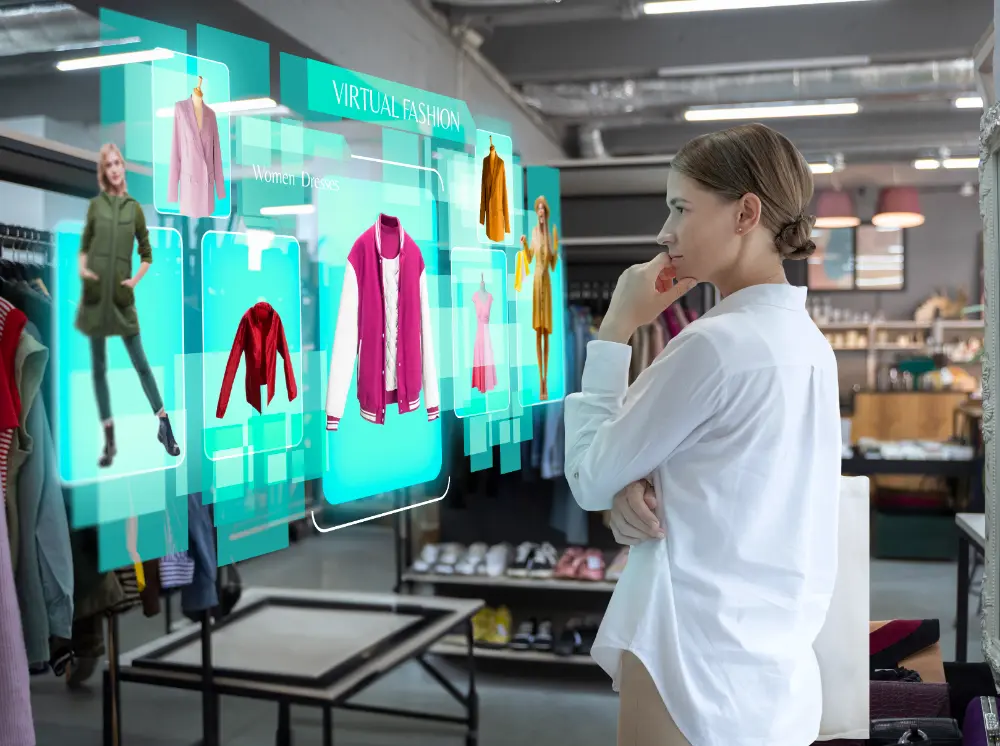
How deep learning solves retail forecasting challenges
22 September 2019
Unified Data Platform & Amazon personalize
30 November 2019

Published by
BluePi
Data-Driven Business Transformation
How AI is making the fashion industry smarter!
Trends in the fashion industry are driven by customer flickering behavior. Change is the only constant in this field. Other than consumer expectations, fashion is also largely impacted by numerous cultural, seasonal, geographical, and social events. However, the world has come together because of the internet. Fashion from different places, different cultures, and varied societies is spreading wings across the globe. Consumer demands, as a result, are surmounting becoming hard to keep up with.
As fashion trends rapidly evolve, the success of brick and mortar stores today completely depends on how effectively and efficiently demand can be met. How well retailers can orchestrate and manage their sales events plays a huge in its profitability. Determining demand of stock in different geographies, accurate calculation of discounts to drive in-store sales, understanding the impact of overstocking inventory on costs, all these are areas that demand attention from retailers who want to keep up with the pace at which fashion changes, and yet emerge profitably.
Even big brands like H&M have failed at this. The brand revealed to its shareholders that it was suffering a loss sitting on $4.3 billion in unsold merchandise, in 2018. These challenges are a green pasture paving an opportunity for AI in the fashion industry to take over.
How AI in the fashion industry has birthed futuristic trends
We’ve talked about how H&M suffered tremendously because of unsold merchandise. What if they could have proactively predicted stock requirements and inventory demand of their clothes, based on geographical data, and historical consumer purchase behavior? What if, say, they could analyze the type of fabric that sells most in India all year round?
Data is the key to predicting demand accurately. And, this is where AI in fashion industry shines. Drawing insights from data and information that consumers leave behind, AI is driving the fashion industry ahead. Clearly AI is the future of the fashion industry. There are various use cases and benefits of AI in the fashion industry, which retail merchants can benefit from. Let’s take them up one by one.
Predicting marketing requirements and consumer behavior
Automating forecasting is a great capability that AI in the fashion industry. You can accurately analyze and predict what the future holds for certain styles, which colors will be more in demand in the coming season, and what prints will not work next summer.
As a result, companies can predict and prevent the manufacturing of large surplus amounts of products that may never be sold. Consider, EDITED, for example. This AI-based technology is a great use case on how AI is assimilated into the future of the fashion industry. The technology is used by the world’s biggest fashion brands to launch the right product at the right price, at the right time. Such predictability of consumer behavior and market requirements is possible only when a machine can process tons of data accurately.
At Fashion Week, brands that use EDITED are able to showcase futuristic fashion trends because of the data they culled out on composite imagery tracking color, texture, print or form, using AI Read More- Data Drive Transformation Affair in Retai
Scaling personal services
Customers no longer consider the quality of the end product as the only parameter to evaluate their shopping experience. Multiple factors, such as how easy it was for them to search the product to how readily the product was shipped to them to how convenient it was to pay for it, make for a collective purchase experience. AI in the fashion industry has truly uplifted the customer shopping experience. Pre and post purchases services, as such, have become really important in the fashion space. And, AI in the fashion industry has come a long way in helping brands scale their personal services.
Dior’s AI Beauty Assistant named Dior Insider is an exceptional example of personal service that uplifts the whole shopping experience. The AI-enabled chatbot on Facebook Messenger platform interacts with users to gather the right information and recommends a highly personalized skincare or makeup products to customers. Similarly, Macy’s On Call pilot is AI in action inside stores. It provides customized responses to customer inquiries through their mobile phones, when they are inside the store and looking for facilities or searching where products or located. We need more such solutions because customization is going to be a big thing in the future of the fashion industry.
AI-assisted manufacturing and design
Did you know that there can be at least 52 seasons for clothing? That’s what they show in the documentary ‘Minimalism’. Designing fashion trends for all these 52 seasons could spell huge costs. And even losses if the prediction about seasonal trends goes wrong.
That’s why fashion manufacturers now rely on the accuracy of the technology and AI in the fashion industry. The switch to AI has helped improve efficiency in predicting fashion requirements as well as fashion manufacturing. Designing for changing consumer preferences requires that manufacturers deploy AI in the textile manufacturing process. Machine intelligence can accurately spot any defects in fabrics, foolproofing the future of the fashion industry. It can also match and check the color of the final fabric with the originally planned color shade.
Shane and Falguni Peacock, Indian Designers have proactively leveraged AI in the fashion industry to scrutinize bulk images available through fashion shows. They use these images to carve out unique and trendy designs that sell. Another good example here is Amazon’s clothing designer. Powered by AI the tool is equipped with powerful algorithms to analyze images and to replicate popular styles on social media. Read More- Success in Supply Chain with AI: Proven Ways
AI for convenience shopping
Visual AI in the fashion industry has made shopping way more convenient than it was a decade ago. Ten years back, if you had to buy a lip shade or a dress, you’d have to try it on before saying yes to it. Today, you don’t need to. There is visual AI to help you get the exact idea of how that lip shade or dress would look on you, without having to try it on. Gap, Ralph Lauren, and Adidas are just a few names in the who have been leveraging visual AI in the fashion industry to elevate the hassle of trying clothing pieces. Search is another major factor when it comes to convenience. And, visual AI in the fashion industry has facilitated even product search in a big way. Apps like Syte.ai help you search for what you are looking for without typing in any text or keywords.
As more and more people turn to virtual-reality based visual AI for shopping, the future of the fashion industry heavily relies on edge computing, a technology that makes data quickly and easily processable. Talking in-depth about edge computing in this post is beyond the scope. However, if you wish to read more on how edge computing works to aid virtual reality aided visual AI, check this post out.
AI for personalization in fashion
On signing up for their monthly subscription, Stitch Fix will send you a box that contains four or five clothing and accessory items. The products are handpicked especially for you based on the information you provide about yourself.
Stitch Fix combines the intelligence and analysis of machine learning with the creative styling skills of humans, to come up with a personalized style statement for its customers. The end result is a super relevant purchase box that you’d love to add to your wardrobe month after month. The algorithm keeps getting smarter with each item you keep and each that you return from your subscription box. Using AI in the fashion industry, Stitch Fix also uses your information from Facebook, Instagram, etc. So, the longer you stick with Stitch Fix as your styling partner, the more accurate and personalized your statement box becomes. As of date, the brand has used artificial intelligence to help more than 2.7 million clients discover their personal style.
Conclusion
Sephora’s Color IQ recommends customized foundation and concealer shades after scanning the shopper’s skin using AI. IBM has partnered with Tommy Hilfiger and the Fashion Institute of Technology to bring about a revolution with AI in the fashion industry. Google is providing its line of clothing via Project Muze. There is simply so much happening and so much that needs to be done yet leveraging AI in the fashion industry. However, while AI can execute and accelerate the process, to bring about innovation with AI you need expert human advice. Implementing AI in the fashion industry might seem like a great idea. But, bringing it to life requires that you plan ahead for the consequences, changes, and results. This is where BluePi comes into the picture. To discuss your requirements out of AI in retail and fashion, get in touch with us.
About the Author

Published by
BluePi
Data-Driven Business Transformation

Published by
Sidhant Arora
Marketing Manager
With 8+ years of brand and marketing expertise, Sidhant has empowered 50+ businesses across industries. His passion lies in crafting impactful 360° strategies that seamlessly blend storytelling and targeted campaigns, guided by data-driven insights. He sculpts compelling narratives that resonate with target audience crafting focused campaigns to expand brand presence across digital, offline, and PR channels to unlock their full potential.






























